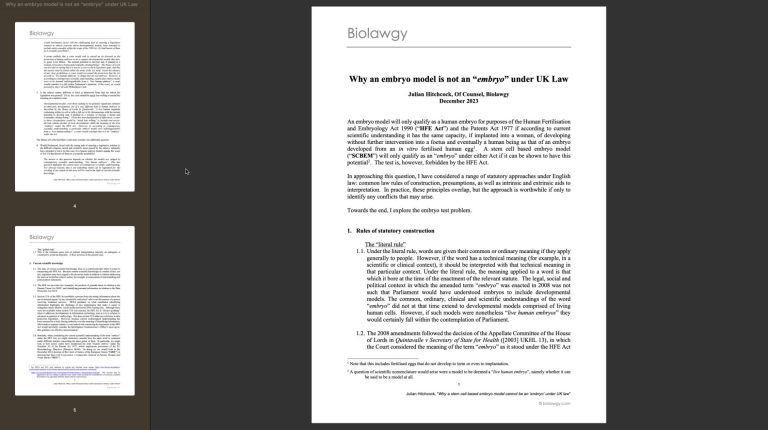OPINION
Why a Human Stem Cell Based Embryo Model Cannot be an 'Embryo' under UK Law
A human SCBEM cannot be an "embryo" under the UK Human Fertilisation and Embryology Act 1990 ("HFE Act") unless verified by an experiment which the Act forbids.
If a test undertaken outside UK law on a particular human SCBEM produced according to a specific protocol leads to a consensus understanding among scientific experts in the field that it would, if implanted into a woman, have the capacity to develop without further intervention into a foetus and on towards live birth, then the tested object will be regulated as an "embryo" under the HFE Act. At this point, it would be misleading to describe the object as a model. Rather, it would be a stem cell based embryo.
Why am I publishing my opinion on the legal status of stem cell based embryo models?
I have chosen to publish an opinion I wrote for discussion purposes last December (around the time of publication in Nature Methods of an article entitled, "‘Ceci n’est pas un embryon?’ The ethics of human embryo model research" (de Graeff, N., De Proost, L. & Munsie, Nat Methods 20, 1863–1867 (2023), which addresses the same area of interest).
Although the opinion has been reviewed by a handful of those interested in the governance of human stem cell based embryo models, it has not been published, because Biolawgy is not a funded academic institution (grants are welcome) and the subject is too scientific for legal journals and too legal for scientific journals. In any event, there is a need for the scientific and legal communities to have access to materials which concern both, a problem exacerbated by firewalls.
Given recent interest shown from institutions and individuals based outside the UK, I have therefore chosen to make it available for wider scientific, legal and regulatory scrutiny and discussion. Please note that it does not recognise my final thinking on this subject. Nor should it be used as legal advice, although I should be happy to provide this is required.
Opinion available for academic and research use here. Please cite as <<Julian Hitchcock, "Why a stem cell based embryo model cannot be an 'embryo' under UK law"; (c) Biolawgy.com 2023 >>.
Copyright subsists. Julian Hitchcock asserts his right to be identified as the author of the work in accordance with the Copyright, Designs and Patents Act 1988.

feb
2024
© Biolawgy Consulting 2023. All rights reserved.
We need your consent to load the translations
We use a third-party service to translate the website content that may collect data about your activity. Please review the details and accept the service to view the translations.